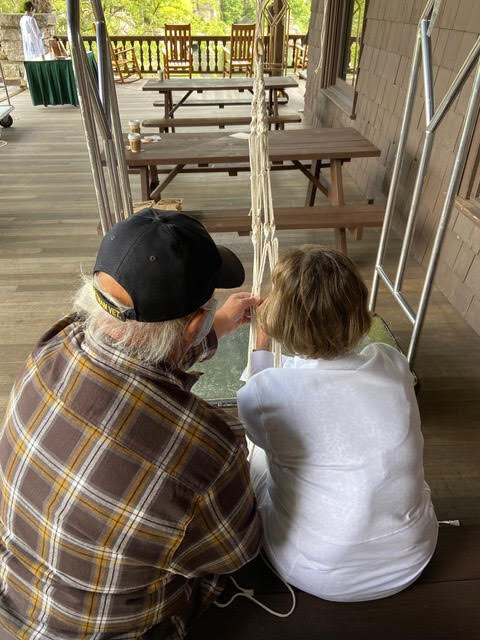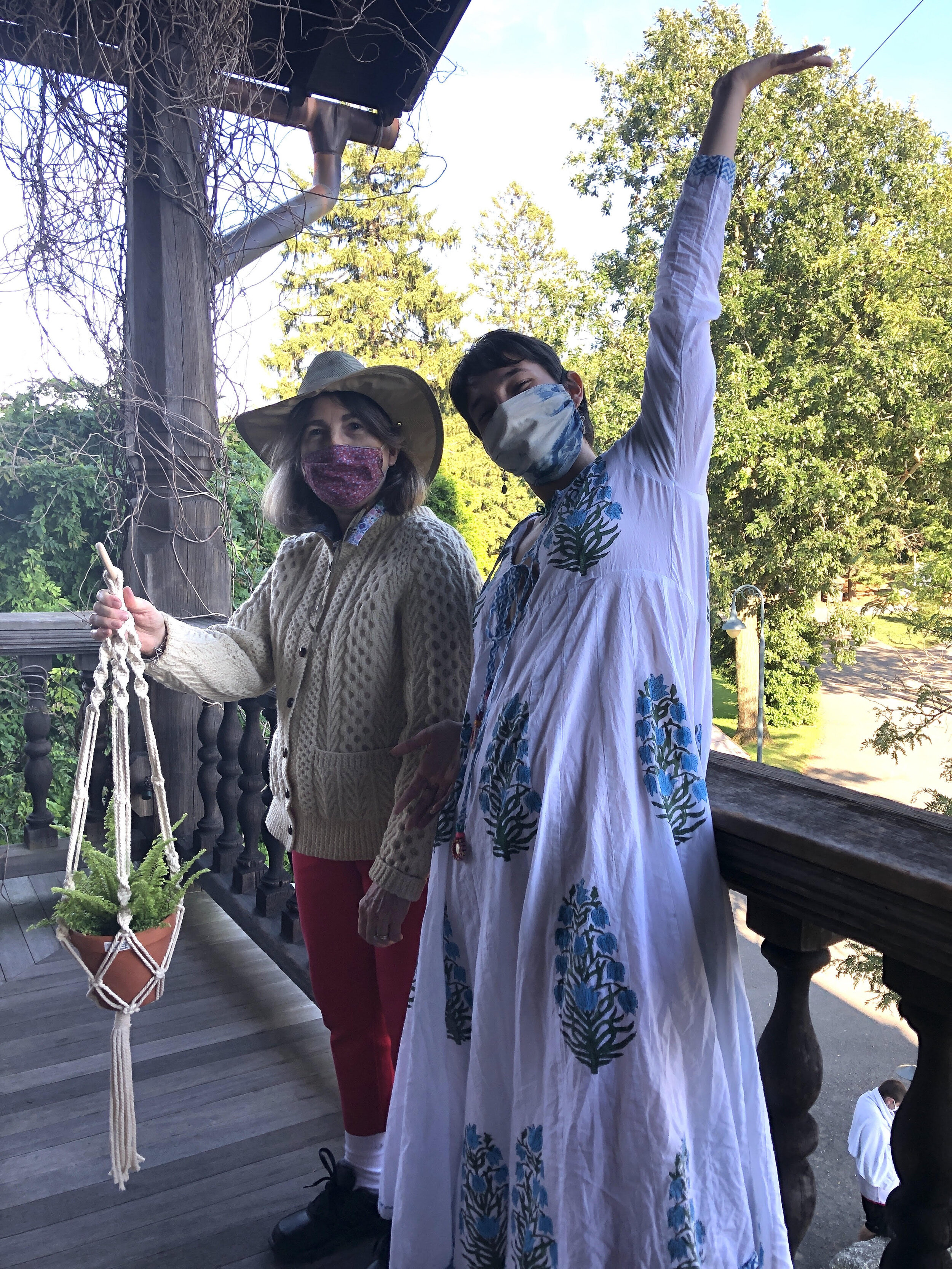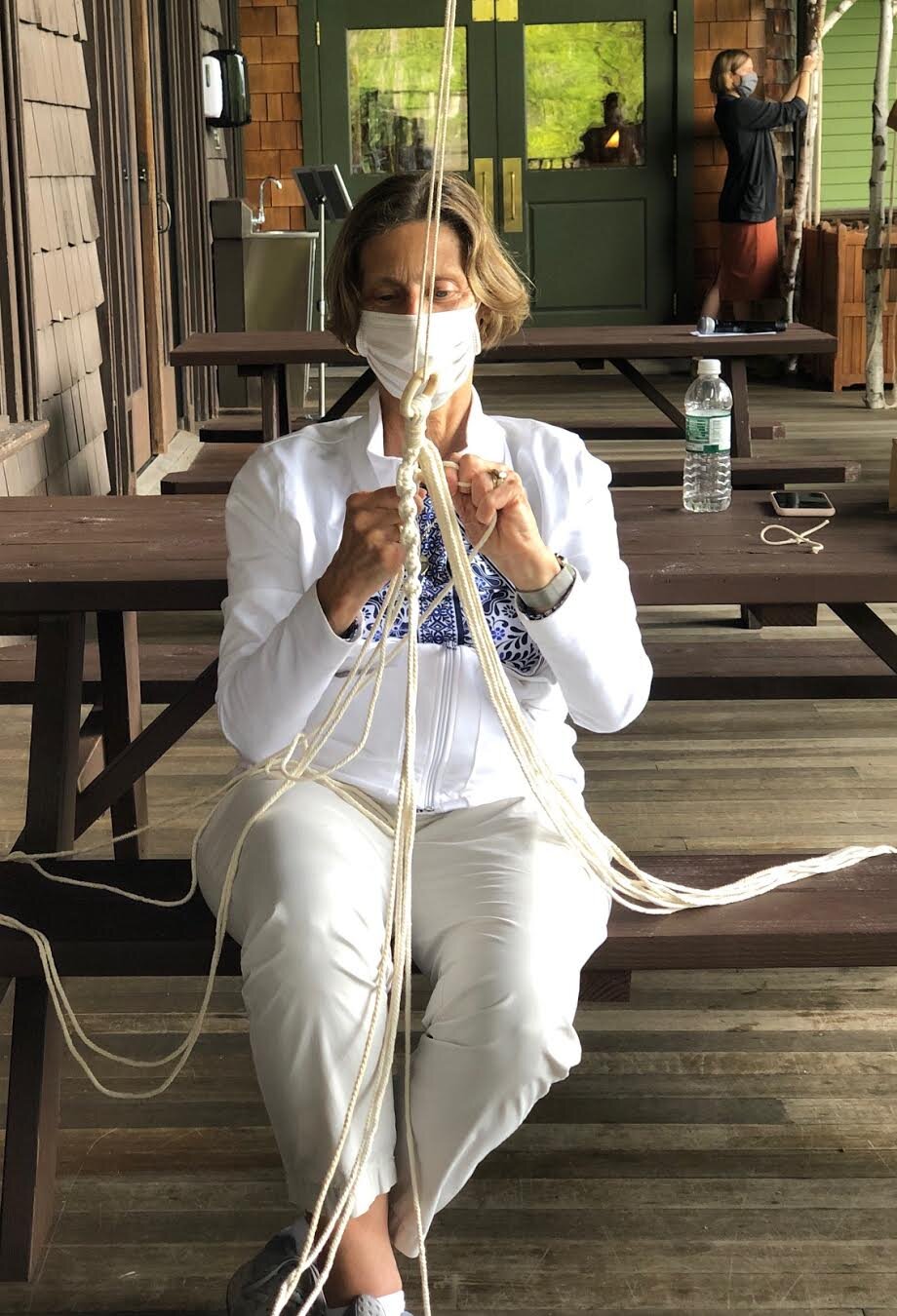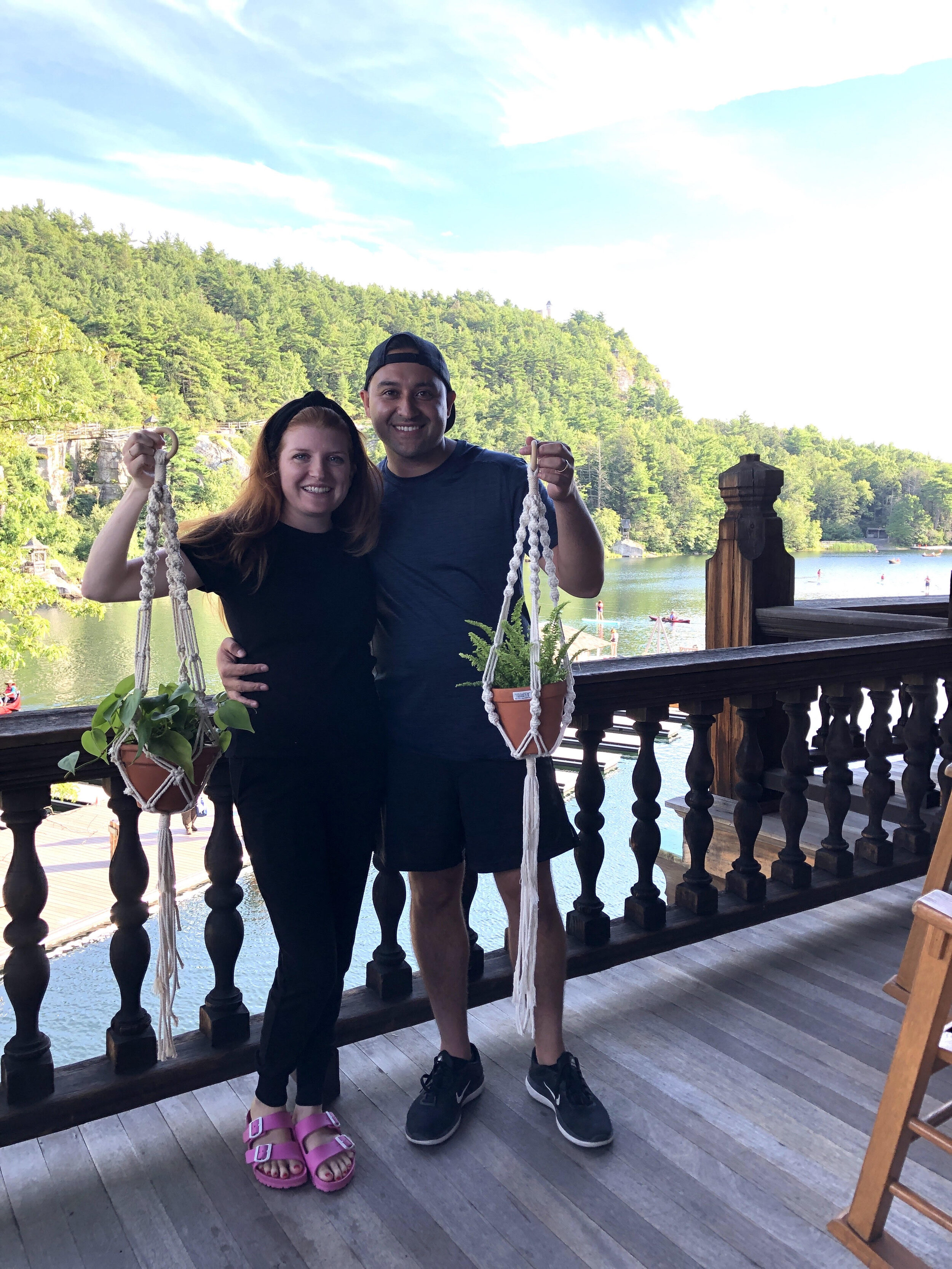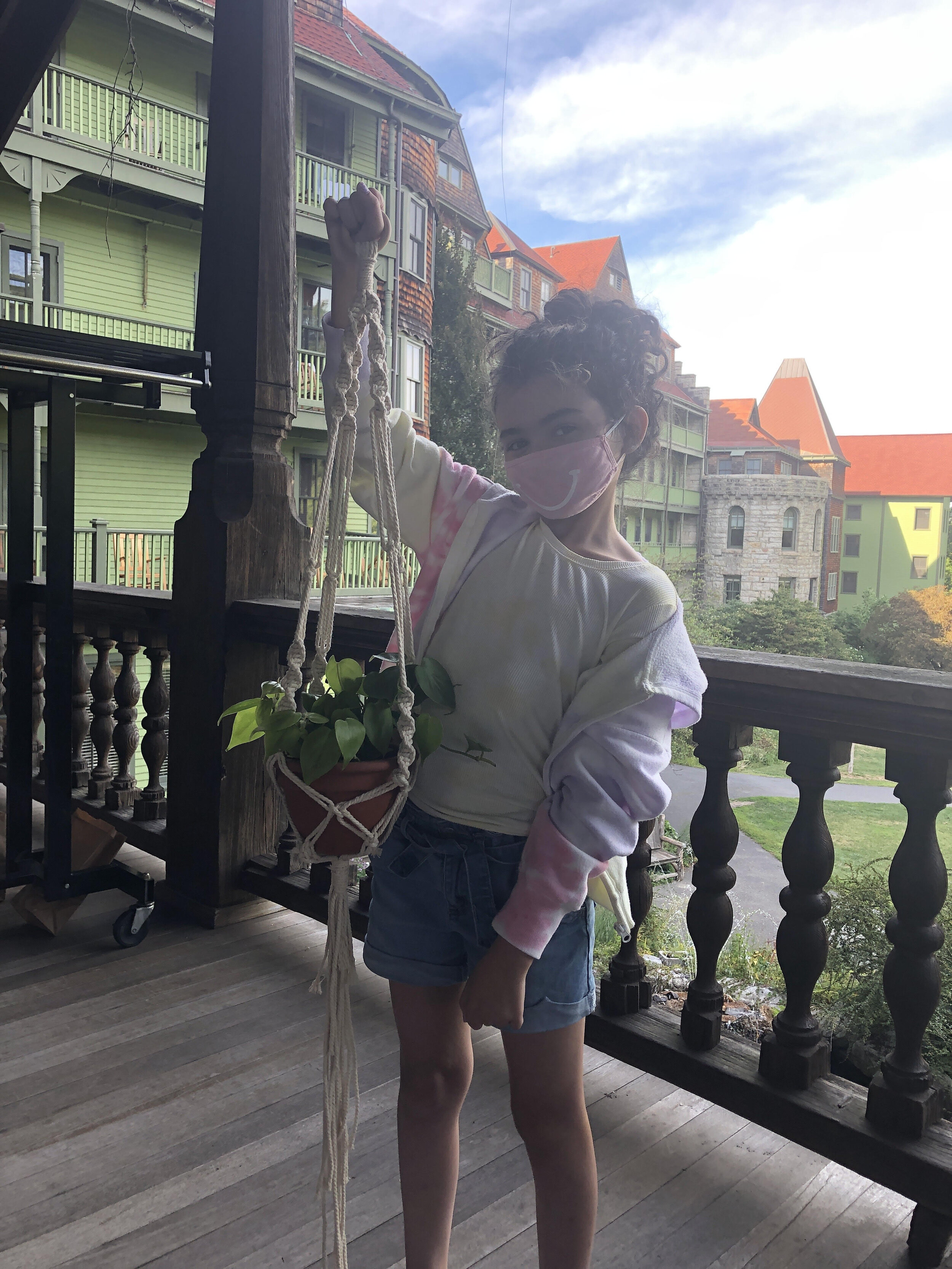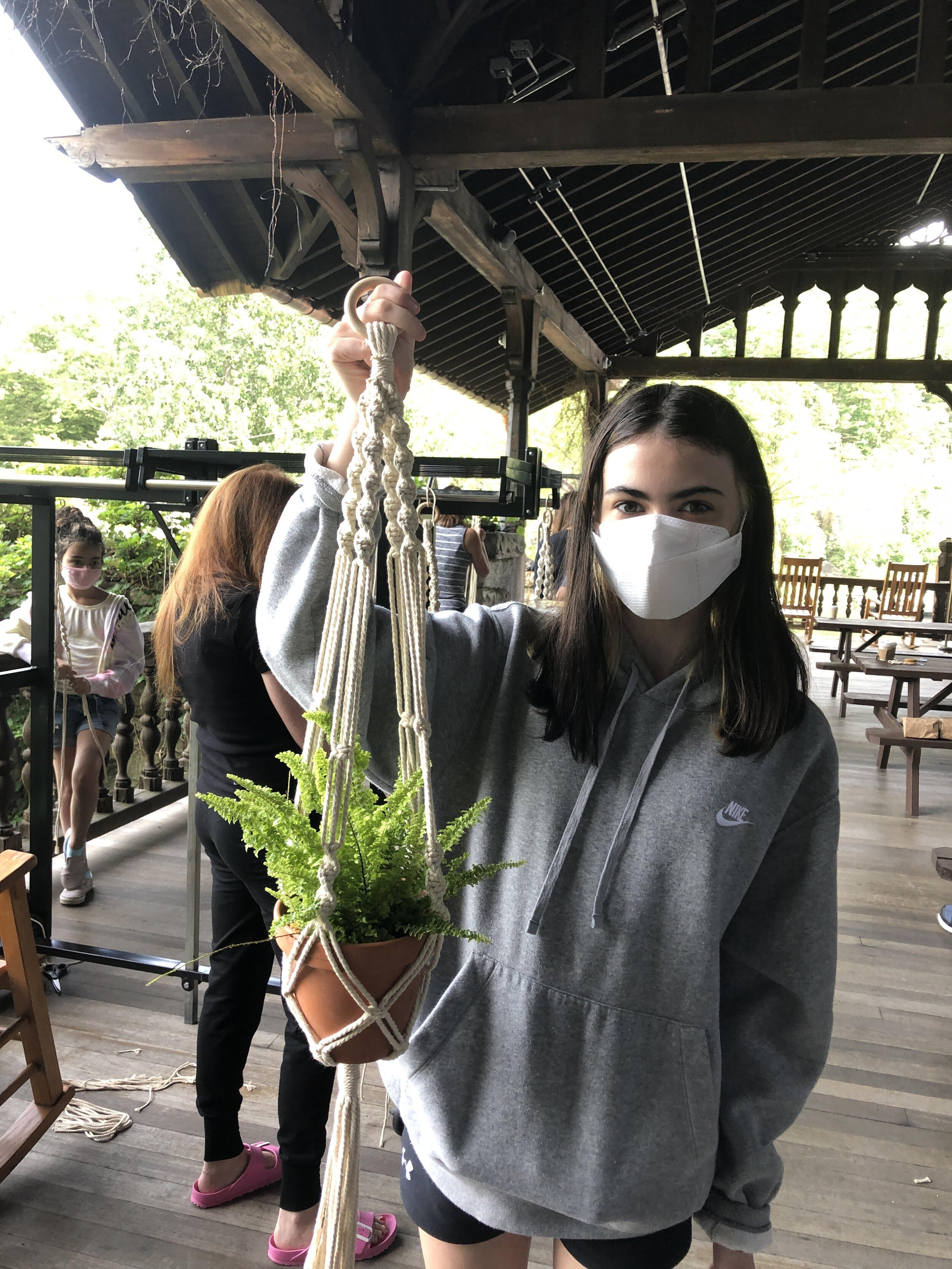Slow Hands Macrame
This Way... or That?
“This way?” a woman asked. “Sorry I have never done this before...over, under, around through...here? Like this?”
Many adults and older children were dispersed on the second floor open deck of Mohonk Mountain House or gathered in clusters of masked couples or relatives, fresh clean air spiraling in from the mountains and off the deep green lake. Fingers tentatively gathered the white cotton cords we had all been invited to work with, while Poliana, one of Circle Creative’s instructors, shared a brief history of macramé.
Please note: Poliana and Melissa used masks generally throughout workshop. For this photo only, they opted out because all three of these lovely humans are in constant contact with one another and very conscientious.
“While idle at sea, sailors made macramé objects which they bartered or sold when they landed at new ports, including hammocks, belts and covers for knife handles and bottles. These designs spread to China and the “New World” of the Americas. Basic knots are known as the reef or the square knot and were made in hemp, leather, and cotton twine or yarn,” she offered in her lilting voice.
Poliana held up what the finished product would look like, a hanging plant holder that to the novice eye looked complex to achieve.
“Take the 4 cords; separate them into a bundle of three on the right, and hold one in your left hand. Then...over-under-around-through...and pull. “ We were soon prompted to unfold the step-by-step instructions (below) that were both graphic and straightforward. It seemed most could follow without hesitation, especially if they focused on the uncomplicated steps just ahead.
This project was specifically selected because any adult and most mature children at varying skill levels can accomplish the tasks, and feel the satisfaction of finishing the project before the end of the workshop. Everyone immediately got to the work of separating the cords, trying out the repetitive movements. People were staring intently at their cords and reticent hands, murmuring quietly, or silently mouthing the words, a collective hymn, soft and rhythmic: over-under-around-through.
“Draw the cords up fairly tight,” added Melissa, one of Circle’s co-founders and a core instructor.
While many progressed quickly, some weavers needed more time to feel confident enough to master the simple movements without overthinking them. After being a part of enough craft workshops with Circle Creative at this point to see a pattern, I can confidently say this: those who have not had the benefits of experience working with craft and the pure pleasure of witnessing their fingers’ own dexterity, may feel their process is not as immediately easeful. This is often because they may be concerned they will “get it wrong” or that they simply haven’t yet allowed their body’s innate intelligence to step in.
Mirabai and Mary Jane, also Circle’s core teachers and co-founders, joined Poliana and Melissa, moving between the students to offer words of encouragement or gentle guidance. Everyone was working with such focused attention and care. Craft is simultaneously such a great equalizer, healer, and a source of empowerment, these small, unpretentious manifestations of ancient knowledge that have been undervalued for far too long. Even those who start as beginners with a skill are soon creators of unique beauty that is a keepsake of the specific moment something was made, yet deeply rooted in a past across cultures.
The trick is focusing on the weave or stitch or bead RIGHT HERE and HERE in front of you, craft forcing us to come into full presence and care, while knowing where we’re going with the overall piece that is being created. It is this that reminds us we can’t get where we’re going without each small step along the way. And we may fumble. And we need to be forgiving. And any blemish or imperfection serves to remind us of the importance of humility, of being just where we are with acceptance, that we may benefit from going even slower, or doubling up on our steps, or being a bit more diligent...all beautiful, wise, and true.
How antithetical to the impatient nature of our immediate-gratification-grabbing culture and how ironic- that we are steeped in a culture that encourages impulse-buy rash-purchases. So we buy things quickly, that are made quickly and without love by people we don’t know, the impact of which is not insignificant on the earth and communities through toxic manufacturing or by-products, that are then shipped far and wide with fossil fuels. And yet... in the name of that “convenience”, in spite of all that time we have supposedly saved, us Westerners often are heard saying we are “chasing time”, “I can’t keep up”, or “there just aren’t enough moments in the day.”
Meanwhile, our two often-undervalued but powerful hands, like Dorothy’s pair of magical ruby slippers, were with us all along to take us home to ourselves and what matters most.
Try it. Move your hands round 4 “mere” cotton cords and you too can suddenly be lifted out from under the stress of your life and of the world, literally finding a still point just by taking slow and careful steps. You can fully immerse in something new and equally as ancient, and in that focusing, you can, for the time it takes to make that macrame plant holder and for sometime after, find actual peace. And one does not have to be perched over a pristine lake in the Hudson Valley to feel a kind of gratification that is so much more immediate and lasting than anything we could ever glean from something purchased. When we learn to make something ourselves, when we remember to take our time, we learn something about humility, connection, and patience, and suddenly have all the time in the world.
-end-
Written by Jenny Wonderling. All images by Circle Creative Collective.
A note from our team: From our Circle family to yours, a SPECIAL THANKS to Onnika and The Mohonk Mountain House for making this workshop possible!
Circle Creative is available for individual instruction, Covid-safe events, and workshops. Please reach out if you want to know more. CONTACT US
BELOW: Our colleague instructor Poliana Danila made a beautiful pattern just for you and wrote each step that needs to be taken in achieving the macrame plant hanger. This is the same one we used in our workshop @ Mohonk. Enjoy!
A Brief History/Herstory of Macrame:
Macramé is thought to have first emerged thanks to early 13th-century Arab weavers whose knotting formed elaborate decorative fringe of hand-loomed fabrics, veils, shawls, and bath towels. It then found its way into 17th-century English courts, went on to become hugely popular in the Victorian era, and was then revived again during the hippie movement of the 60’s and 70’s, and has found a great resurgence again more recently for wall hangings, plant hangings, clothing and jewelry. Cavandoli macramé is another gorgeous style that creates geometric and free-form patterns using the double half-hitch knot.
According to www.ancienthearthealing.com: “The Spanish word macramé is derived from the Arabic migramah (مقرمة), believed to mean “striped towel”, “ornamental fringe” or “embroidered veil.” After the Moorish conquest, the art was taken to Spain, then to Italy, especially in the region of Liguria, and then spread through Europe. It was introduced into England at the court of Mary II in the late 17th century. Queen Mary taught the art of macramé to her ladies-in-waiting…
To read more CLICK HERE




